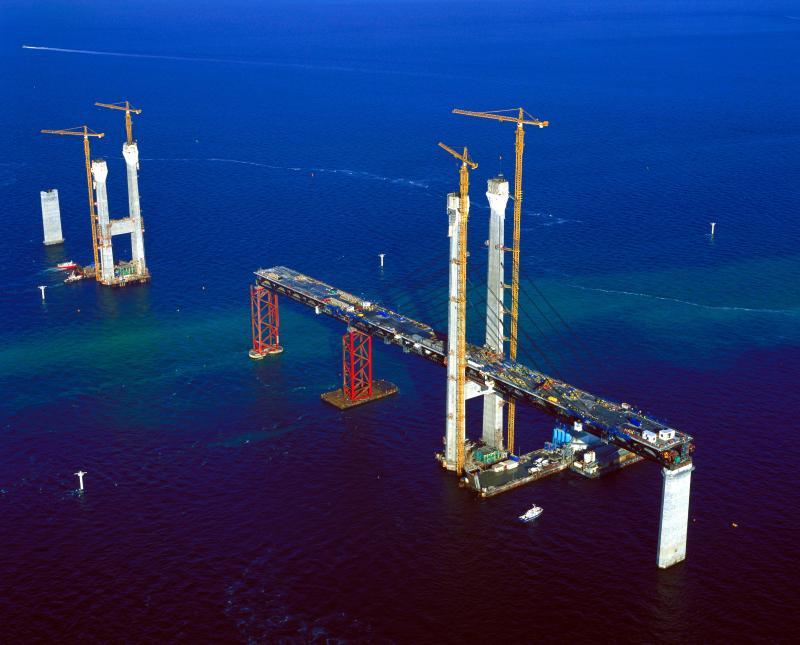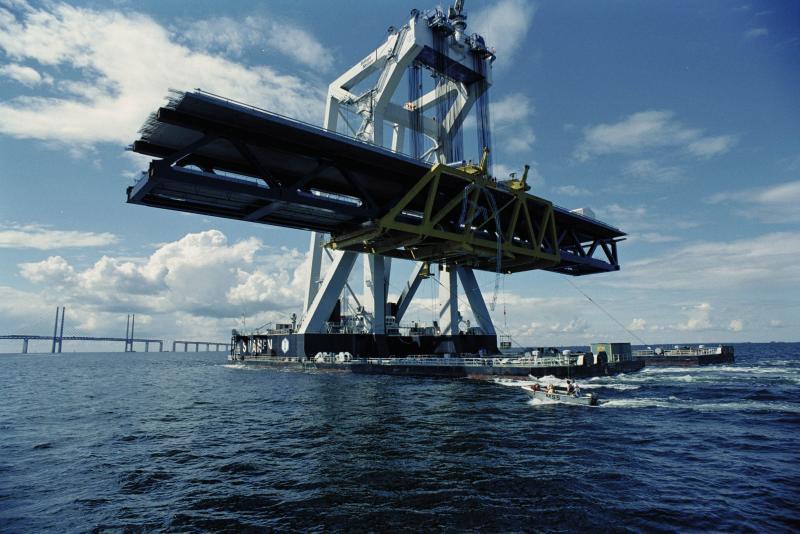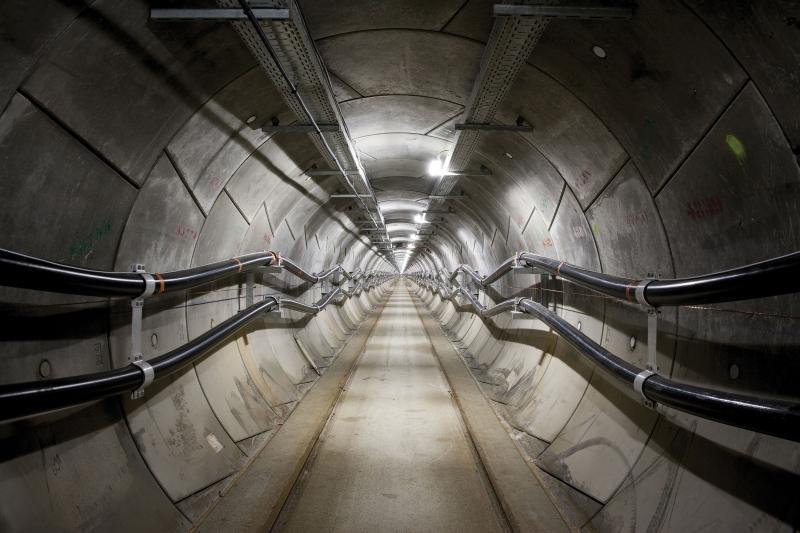The 1990s saw the construction of the Öresund Bridge, a vital transport link in the Trans European Network—and one Swedish motorcyclist’s daily moment of zen
Amid the splendour of Michelangelo’s architectural innovations at the Palazzo dei Conservatori on the Capitoline Hill, delegates from six European countries signed the Treaty of Rome on 25 March 1957. The treaty, which included the articles that founded the European Investment Bank, was “a declaration of future good intentions,” according to one historian. For two weeks, we are publishing a series of stories to mark the sixtieth anniversary of the treaty—one for each decade of the EIB story. These are stories of how the EIB helped turn good intentions into reality.
Donwload the book, available in PDF and epub format.
With the scent of the sea in his nostrils and the fresh air against his face and the bright water stretching so far away, Ola Ghatnekar crosses the Öresund Bridge on his Kawasaki ER-6n. The four-stroke engine powers him high over the narrow channel between his native Sweden and Denmark. He is on his way from his home in Malmö to work as a health economist in Kastrup, just outside Copenhagen. But for now his mind is clear of the stresses of office life. “It’s really something,” he thinks. “A little moment of mindfulness.” The tang of the water makes him emotional. It is so beautiful up here. It is what everyone says when you ask them about the Öresund Bridge. It is so beautiful.
But right now Ghatnekar really feels it. Up here on the bridge, the sweeping, steel-girdered, 82 000-tonne connection built between 1995 and 1999. He rides one of the four road lanes on the top of the bridge, while his wife Anna is on a train to Copenhagen on the lower deck. When he gets to work, it is only 24 minutes since he twisted the clutch and powered his Kawasaki out of Malmö. He has passed across the three cable-stayed sections of the bridge—the longest is almost 500 metres—and down into the Drogden Tunnel, the second part of the crossing, a 3 510 metre tube made up of 20 reinforced concrete segments each weighing 55 000 tonnes.
He leaves his bike in the parking lot and goes into the office. Half of his colleagues are Swedes who have made the same crossing, either by motorbike or car or train. All of them, crossing to jobs that they might not have been able to take before the bridge. Ghatnekar’s wife used to spend hours each day on a hydrofoil, forced to use her elbows to get through the crowds, then jolted by the waves for forty-five minutes. Compare that to the moment of peace Ghatnekar experiences now.
“I would never have done it. I would not have been working in Denmark without the bridge,” he says. At the end of the day, Ghatnekar rides back to a city transformed by this bridge, which brought the job opportunities of Copenhagen to Swedes and cheaper housing to Danes priced out of the property market in their capital city.

Advantages of the route
The site of the Öresund Bridge was not always seen as the most likely way to cross the strait between Sjaellandand Skåne. Less than 50 kilometres to the north, the straits at Helsingør in Denmark and Helsingborg in Sweden are narrower. Traditionally ferries ran between the two cities with passengers and freight—and continue to do so. Many Danes opposed the idea of a bridge there, fearing that it would simply add traffic to their roads and make them a transit point for Swedish trucks on their way to the rest of Europe. Instead, by moving the bridge to its final position, the Danes were able to
- bring Swedish traffic to Copenhagen Airport, which is right at the point where the crossing is completed
- boost the city’s labour market with new workers from Malmö
- provide an alternative housing stock across the water.
“The bridge isn’t just about transit,” says Maj Theander, who worked on the EIB’s financing for the Öresund Bridge trains and went on to be head of mobility at the Bank. “It’s also about regional integration.”
“It’s a very successful story and it shows how the TEN-T is supposed to work,” says Theander, who grew up near Helsingør.
TEN-T flagship
At the start of the 1990s, the 12 Member States set up the Trans-European Networks to support the development of infrastructure across the EU. TEN-T is the transport element, though there are other TEN programmes, like TEN-E for energy networks. “It’s a European objective to have international corridors for trade, integration, and mobility within the EU,” says Theander, who is now head of the safeguards and quality management department. “They break down physical barriers. In terms of TEN-T, the Öresund Bridge is a flagship project.”
The bridge certainly has a big influence on life around it. A third of Swedes and two-thirds of Danes live in nearby areas. Every day 75 000 people use the bridge, 45% of them taking the 35-minute train ride. More than half of freight between Sweden and Denmark crosses the bridge. According to a regional organisation representing Öresund-area municipalities and governments, the bridge has been worth EUR 8.4 billion to the economies of Sweden and Denmark. That’s a good payback on a EUR 4 billion project, almost half of which was financed by the EIB.
“It has made a big difference to Malmö, and also to Copenhagen,” says Britt Andresen, chief analyst at the Öresund Institute, a regional member-financed non-profit organisation based in Malmö.

A bridge for labour
Early in the 1990s Malmö lost a series of industrial businesses within a matter of months. Added to the closure of the shipyard not long before, the result was high unemployment. With the arrival of the bridge, the city’s prospects changed profoundly. Copenhagen’s international airport was now just minutes away, so a number of corporations set up their headquarters in Malmö. The increased traffic from Swedish travellers allowed the airport to attract more carriers and more routes, which in turn made Malmö still more attractive. When Copenhagen property prices skyrocketed between 2004 and 2006, many Danes found more affordable housing across the bridge in the Malmö area. In the other direction, companies in Copenhagen were able to hire from an expanded pool of workers in Sweden. “The bridge was really essential for the Copenhagen labour market,” says Andresen. “It brings people from Malmö and also from Lund across to work in Copenhagen.”
Of course, like everyone else in the region, Andresen doesn’t see the bridge in purely economic terms. Driving home from Copenhagen one recent night with a friend, she looked out across the water with the moon reflected on the surface of the sea. “Wow, what a beautiful moment,” she thought. “It really is such a beautiful bridge.”

Energy lifelines
The Öresund Bridge is a TEN-T flagship. What about the TEN-E lines that move electricity and gas around the continent?
Crawl through a tunnel 8.5 kilometres long under the Pyrenees and you will be following the trail of energy integration’s future. The tunnel is part of a 63-kilometre interconnector that carries electricity between Santa Llogaia, near Figueres in Spain, and Baixas, close to Perpignan in France. Completed in 2015, this collaboration between RTE and REE, the French and Spanish electricity transmission system operators, doubled the electricity exchange capacity between the Iberian Peninsula and the rest of Europe to 2 800MW. The benefits flow in both directions through the exchange of surplus renewable generation from wind and hydro, and more efficient use of gas and nuclear plants, creating greater security of supply. The project was the first line to cross a European border using innovative high-voltage direct current technologies that offer big advantages over traditional techniques. The cables are lighter and easier to install and the converters make for more flexible operation of the interconnector. Almost half of its EUR 721 million cost was funded by the EIB.
Energy infrastructure is capital intensive. But its development is key for the EU, so that energy markets can be integrated and energy and climate goals met. It’s also a crucial prerequisite for EU economic strategy, which aims to enable consumers to benefit from new technologies and smart, efficient energy use. The benefits of full market integration by 2030 have been put at EUR 30 billion per year for gas markets and as much as EUR 40 billion a year for electricity markets, according to a study carried out for the European Commission. The EIB has extended loans of EUR 19 billion to EU Projects of Common Interest contributing to the integration of energy markets since 2000, of which EUR 7.4 billion enhance cross-border electricity transmission capacities and EUR 11.6 billion are for gas transmission. Support for the construction of infrastructure is the Bank’s main role in this vital sector. The EIB invests in projects that support growth, energy security, and the sustainability of energy production and use in European markets. “These are all efforts to guarantee everyone access to affordable, clean, resilient and sustainable energy systems,” says Nicola Pochettino, head of the EIB’s electricity networks division.
While the EU works to harmonise different national energy regulations, the EIB’s work allows countries to put them into effect. You can give consumers and businesses the right to do something, but if you don’t build the pipes and cables to enable them actually to do it, the benefits will obviously never accrue. This is a vital consideration in areas of Europe which have been less integrated. After the Santa Llogaia-Baixas connection, commercial exchange capacity between Spain and France doubled, though further interconnectors need to be developed to meet EU targets.
Interconnections that drive down prices
The impact of such projects is tremendous in southern Europe. For the Baltic States it is even more significant, because they remain part of the old power systems of the Russian Federation and are highly dependent on Russian gas supplies. In the current political situation, that is a risk to their energy security. The EIB is funding a number of projects to integrate the Baltics fully into the EU’s internal market. In Klaipėda, the EIB financed a liquefied natural gas import terminal and the gas pipeline that connects it to Lithuania’s gas network. The terminal and the pipeline make Lithuania less dependent on Russian gas, in this case because it can be supplied by sea. Further investment in the gas network pipelines, including the EIB-financed 110-kilometre pipeline between Klaipėda and Kursenai in Lithuania, moves towards ensuring that Latvia and Estonia can also benefit from an alternative to Russian gas. The competition from the new supply option has been key in driving a 20% reduction of Russian gas prices to Lithuania.
